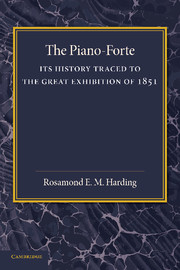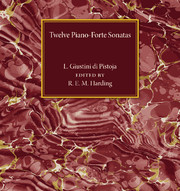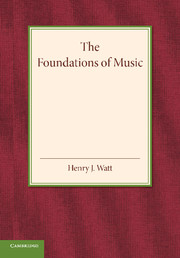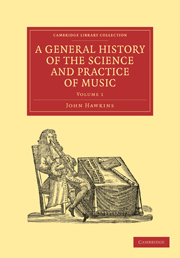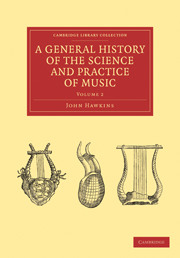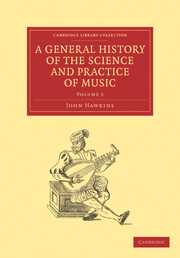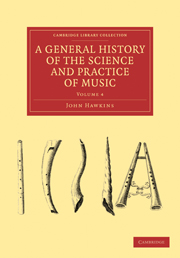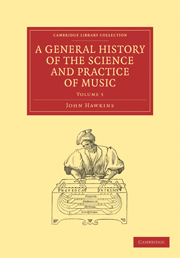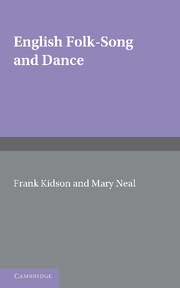The Piano-Forte
Its History Traced to the Great Exhibition of 1851
£33.99
- Author: Rosamond E. M. Harding
- Date Published: July 2014
- availability: Available
- format: Paperback
- isbn: 9781107418271
£
33.99
Paperback
Looking for an inspection copy?
This title is not currently available on inspection
-
Originally published in 1933, this book provides a detailed history of the piano-forte from its invention in Italy in the eighteenth century until the presentation of the first European cast-iron frame for a piano at the 1851 Great Exhibition. Harding also analyses the role of the piano as a replacement for a chamber orchestra and its history as a domestic instrument. The text is richly illustrated with images of pianos produced by a variety of makers over time, as well as with images of piano machinery taken from patent registrations. This thoroughly-researched book will be of value to anyone with an interest in one of the most ubiquitous instruments in the Western world and the history of its development.
Customer reviews
Not yet reviewed
Be the first to review
Review was not posted due to profanity
×Product details
- Date Published: July 2014
- format: Paperback
- isbn: 9781107418271
- length: 528 pages
- dimensions: 230 x 153 x 35 mm
- weight: 0.85kg
- availability: Available
Table of Contents
Preface
List of plates
List of abbreviations
Part I. The Pianoforte in the Eighteenth Century:
1. The invention of the pianoforte in Italy
2. The invention of the pianoforte in France
3. The invention and development of the pianoforte in Germany
4. The tangent action and the cembalo stop
5. The pianoforte in England
6. Later developments in France
7. The pianoforte in America
8. The musical significance of the new instrument
Part II. The Pianoforte in the Nineteenth Century
Section 1. The Pianoforte as a Chamber Orchestra:
1. The pianoforte as a chamber orchestra
2. Devices for the purpose of sustaining the tone
3. Octave couplers and 'Duoclave' pianofortes
4. The influence of programme music upon the pianoforte
5. The influence of Turkish music upon the pianoforte
6. Turkish music and other pedals
Section 2. The Pianoforte as a Solo Instrument in the Early Nineteenth Century:
1. The concert grand pianoforte
2. Some improvements in the construction of the pianoforte relating to the production of a loud and sonorous tone
3. The metal frame
4. Pitch and temperament
Section 3. The Pianoforte as a Domestic Instrument:
1. The upright pianoforte
2. Some other types of pianofortes in the home
3. Pedal, transposing and self-acting pianofortes, experimental keyboards
4. Tuning the pianoforte and apparatus for keeping the pianoforte in tune
Appendix A. Technical terms
Appendix B. Bibliography
Appendix C. List of patents
Appendix D. Concerning wire
Appendix E. Felt-making
tinder and sponge for hammer heads
process of tanning leather for hammer heads
Appendix F. Prices of pianofortes and of materials used in their manufacture
Appendix G. Select list of English pianoforte makers in London and its environs up to the year 1851
Appendix H. A note on pedal signs
Index.-
General Resources
Find resources associated with this title
Type Name Unlocked * Format Size Showing of
This title is supported by one or more locked resources. Access to locked resources is granted exclusively by Cambridge University Press to lecturers whose faculty status has been verified. To gain access to locked resources, lecturers should sign in to or register for a Cambridge user account.
Please use locked resources responsibly and exercise your professional discretion when choosing how you share these materials with your students. Other lecturers may wish to use locked resources for assessment purposes and their usefulness is undermined when the source files (for example, solution manuals or test banks) are shared online or via social networks.
Supplementary resources are subject to copyright. Lecturers are permitted to view, print or download these resources for use in their teaching, but may not change them or use them for commercial gain.
If you are having problems accessing these resources please contact [email protected].
Sorry, this resource is locked
Please register or sign in to request access. If you are having problems accessing these resources please email [email protected]
Register Sign in» Proceed
You are now leaving the Cambridge University Press website. Your eBook purchase and download will be completed by our partner www.ebooks.com. Please see the permission section of the www.ebooks.com catalogue page for details of the print & copy limits on our eBooks.
Continue ×Are you sure you want to delete your account?
This cannot be undone.
Thank you for your feedback which will help us improve our service.
If you requested a response, we will make sure to get back to you shortly.
×
